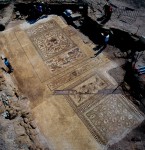 The Lod mosaic, one of the largest and most complete Roman mosaic floors ever found, was discovered by accident during highway construction in the Israeli city of Lod, 10 miles southeast of Tel Aviv, in 1996. The initial excavation revealed a floor 50 feet long by 27 feet wide with a series of kaleidoscopic mosaics depicting animals at hunt, great sea creatures and fish crowding ships, urns and floral garlands, birds perched on branches and small, individual birds and fish all framed with bold black lines, geometric shapes and intricate knots. The total mosaic covered 600 square feet and was composed of two million individual tesserae (tiles).
The Lod mosaic, one of the largest and most complete Roman mosaic floors ever found, was discovered by accident during highway construction in the Israeli city of Lod, 10 miles southeast of Tel Aviv, in 1996. The initial excavation revealed a floor 50 feet long by 27 feet wide with a series of kaleidoscopic mosaics depicting animals at hunt, great sea creatures and fish crowding ships, urns and floral garlands, birds perched on branches and small, individual birds and fish all framed with bold black lines, geometric shapes and intricate knots. The total mosaic covered 600 square feet and was composed of two million individual tesserae (tiles).
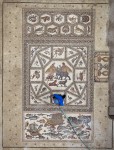 Pottery sherds and coins found littering the floor dated it to the early 4th century A.D., and while no other parts of the structure were found, archaeologists believe it was a private home whose frescoed mud-brick walls had collapsed onto the floor preserving the mosaics for 1,700 years. Different sections of the mosaic were installed at different times and designed by different artists. The three north panels — individual animals in hexagonal frames, the largest panel with smaller animal and hunting scenes in triangular frames around a central octagonal mountain hunting scene, the great marine scene — were made by one mosaicist. The two south panel with birds on branches and fish and birds in frames were made by another. The urn and garland panel between them was made by a third artist, the least accomplished of the three, and was likely the last one to be installed. It probably took around three years for the whole floor to be completed.
Pottery sherds and coins found littering the floor dated it to the early 4th century A.D., and while no other parts of the structure were found, archaeologists believe it was a private home whose frescoed mud-brick walls had collapsed onto the floor preserving the mosaics for 1,700 years. Different sections of the mosaic were installed at different times and designed by different artists. The three north panels — individual animals in hexagonal frames, the largest panel with smaller animal and hunting scenes in triangular frames around a central octagonal mountain hunting scene, the great marine scene — were made by one mosaicist. The two south panel with birds on branches and fish and birds in frames were made by another. The urn and garland panel between them was made by a third artist, the least accomplished of the three, and was likely the last one to be installed. It probably took around three years for the whole floor to be completed.
The exceptional beauty and rarity of find vaulted the mosaic to international fame. The mosaic was opened to the public for one weekend and during those two days 10,000 people came to see it. The Israeli Antiquities Authority (IAA) didn’t have the budget to properly conserve such a huge masterpiece, so after that one weekend of public display, the floor was reburied for its own protection.
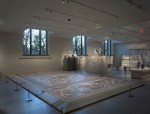 In 2009, a $2.5 million gift from the Shelby White and the Leon Levy Foundation gave the Israel Antiquities Authority the wherewithal to re-excavate the mosaic, lift it from the floor (they found footprints and drawing lines in the mortar bedding), clean it and conserve it for exhibition. The three sections of the north panel, the best preserved and most intricate design, toured the United States starting in 2010 and moved on to Europe in 2013. It is now at the Cini Gallery in Venice.
In 2009, a $2.5 million gift from the Shelby White and the Leon Levy Foundation gave the Israel Antiquities Authority the wherewithal to re-excavate the mosaic, lift it from the floor (they found footprints and drawing lines in the mortar bedding), clean it and conserve it for exhibition. The three sections of the north panel, the best preserved and most intricate design, toured the United States starting in 2010 and moved on to Europe in 2013. It is now at the Cini Gallery in Venice.
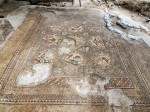 The donation also made possible the construction of the Shelby White and Leon Levy Lod Mosaic Archaeological Center, a museum dedicated to the mosaic built on the discovery site. The traveling panels were reinstalled in their original location and the building went up around the floor. The center was originally scheduled to open in late 2014, but that date was pushed back, and with good reason. Between June and November of 2014, IAA archaeologists surveyed an unexcavated area south of the previously unearthed mosaic in advance of construction.
The donation also made possible the construction of the Shelby White and Leon Levy Lod Mosaic Archaeological Center, a museum dedicated to the mosaic built on the discovery site. The traveling panels were reinstalled in their original location and the building went up around the floor. The center was originally scheduled to open in late 2014, but that date was pushed back, and with good reason. Between June and November of 2014, IAA archaeologists surveyed an unexcavated area south of the previously unearthed mosaic in advance of construction.
The IAA announced Monday that during the survey they discovered another huge mosaic just yards away from where the first one was found.
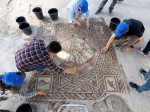 The second Lod mosaic is 36 feet by 42 feet and is part of the same private villa. The newly discovered mosaic shares the same themes of animals at hunt, fish, birds, urns and floral elements, and is of outstanding artistic quality. This mosaic decorated the floor of the villa’s courtyard, while the first mosaic decorated the floors of several reception rooms where the homeowner would have entertained clients and guests. The courtyard was surrounded by porticos, covered walkways, with lines of columns supporting the ceiling, none of which survive, although numerous fragments of wall frescoes have been recovered.
The second Lod mosaic is 36 feet by 42 feet and is part of the same private villa. The newly discovered mosaic shares the same themes of animals at hunt, fish, birds, urns and floral elements, and is of outstanding artistic quality. This mosaic decorated the floor of the villa’s courtyard, while the first mosaic decorated the floors of several reception rooms where the homeowner would have entertained clients and guests. The courtyard was surrounded by porticos, covered walkways, with lines of columns supporting the ceiling, none of which survive, although numerous fragments of wall frescoes have been recovered.
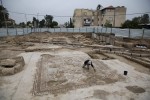 This elegant, expensively appointed home was part of a wealthy enclave during the Roman and Byzantine eras. Founded by Canaanites around 5600–5250 B.C., the city of Lydda was destroyed by Rome during the First Jewish War (66 A.D.) and besieged in the Second Jewish War (115-117 A.D.) Much of the Jewish population was slaughtered and the Christian population increased significantly in the years afterwards. In 200 A.D. the emperor Septimius Severus granted it city status and named it Colonia Lucia Septimia Severa Diospolis. It was the district capital and a regional center of commerce and government administration. The owner of the villa was part of the city elite, either an official or a rich merchant.
This elegant, expensively appointed home was part of a wealthy enclave during the Roman and Byzantine eras. Founded by Canaanites around 5600–5250 B.C., the city of Lydda was destroyed by Rome during the First Jewish War (66 A.D.) and besieged in the Second Jewish War (115-117 A.D.) Much of the Jewish population was slaughtered and the Christian population increased significantly in the years afterwards. In 200 A.D. the emperor Septimius Severus granted it city status and named it Colonia Lucia Septimia Severa Diospolis. It was the district capital and a regional center of commerce and government administration. The owner of the villa was part of the city elite, either an official or a rich merchant.
The site is bounded by modern buildings on the east side, so the entire home cannot be excavated. The new discovery will be incorporated into the visitor center.
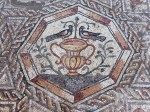
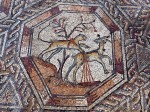
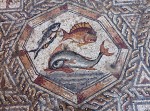
For an in-depth examination of the first Lod mosaic and its significance, watch these videos compiled by the Metropolitan Museum of Art. First is a short film documenting the original find and the lifting of the mosaic in 2009. The next to are lectures given during the mosaic’s stop at the Met in 2011 about the discovery of the mosaic, the interpretation of its imagery and the influence of Rome on local art.
[youtube=https://youtu.be/ZSq5Xc29XPA&w=430]
[youtube=https://youtu.be/J8IW4y6xGUQ&w=430]
[youtube=https://youtu.be/CaqcSFc05-Q&w=430]